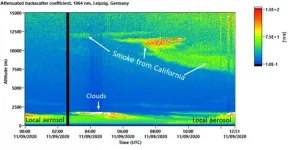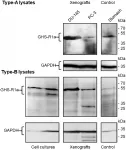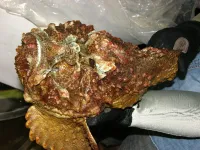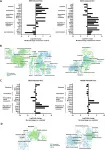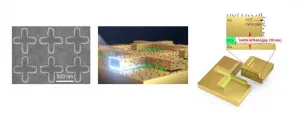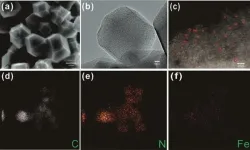(Press-News.org) Amsterdam, June 1, 2021 - The Treatabolome project is a research initiative to develop a freely available, interoperable online platform dedicated to disseminating rare disease and gene-specific treatment information to healthcare professionals regardless of their level of specialized expertise. Developed under the Solve-RD European Research Project, it is intended to reduce treatment delays for patients with rare diseases by directly linking diagnosis and treatment information. This initiative is highly relevant to neuromuscular disorders as they are rare diseases by definition. In this special issue of the Journal of Neuromuscular Diseases, experts contribute Treatabolome-feeding systematic literature reviews on rare neurological and neuromuscular disorders.
In Europe, rare diseases are defined as those that affect one in two thousand individuals or fewer. Although they are individually rare, globally they affect around 6% of the population. Collectively, healthcare providers deal with a considerable number of patients with a rare disease, over 70% of which are genetically determined. Historically, around 25% of patients with rare diseases have endured a diagnostic odyssey that can last up to 30 years, according to Eurordis, an alliance of over 900 patient organizations that work together to improve the lives of people living with a rare disease.
Next generation sequencing has made it possible to efficiently diagnose a growing number of rare diseases. At the same time, new and frequently specific treatments are emerging following decades of expectant wait by patients, their families, and caretakers. To deliver such treatments to patients in an expedient manner, diagnosis and treatment now need to be linked consistently.
"The Treatabolome project arises from the improved availability of genetic diagnosis and the rapidly growing number of rare disease treatments," explained Guest Editor Gisèle Bonne, PhD, Sorbonne Université, Inserm, Institut de Myologie, Centre de Recherche en Myologie, Paris, France. "There are treatments available for an increasing number of rare diseases, but there is often a substantial delay before patients receive the right treatment. Although targeted treatments are currently only available to a minority of patients with rare diseases, recent developments point towards a steep increase in the coming years, as suggested by the development of multiple gene therapies and the steady increase in the number of orphan drug applications."
This EU project involves four European Reference Networks or ERNs: ERN-RND for Rare Neurological Diseases; ERN Euro-NMD for Rare Neuromuscular Diseases; ERN-ITHACA for rare congenital malformations and syndromes with intellectual and other neurodevelopmental disorders; and ERN-GENTURIS for patients with one of the rare genetic tumor risk syndromes.
The special issue covers gene and variant-specific treatments for rare neurological and neuromuscular disorders, highlighting the important premise that a precise genetic diagnosis may result in an equally precise therapeutic approach. It includes systematic reviews from internationally leading centers representing a concentration of rare diseases expertise involved in producing Treatabolome-feeding literature reviews, which cover:
Genetic forms of Parkinson's disease
Skeletal muscle ion channelopathies
Hereditary peripheral neuropathies
Metabolic myopathies related to glycogen storage and lipid metabolism
Laminopathies
The issue also includes a review of the underlying disease mechanisms, potential therapeutic approaches, and the state of trial readiness of future clinical trials in facioscapulohumeral muscular dystrophy (FSHD).
The intention is that as the Treatabolome platform is finalized, the main body of data will be derived from expert-led systematic literature reviews such as those published in the current issue. They bring state-of-the-art, evidence-based information in a standardized format that is FAIR-compatible and easily uploadable to the Treatabolome database.
"When combined with diagnosis support tools like RD-Connect's Genome-Phenome Analysis Platform (GPAP), the Treatabolome prevents treatment-onset delays," noted Dr. Bonne. "It puts flesh of content onto the bones of the platform."
One of the next steps of the Treatabolome project will be to extend it to rare diseases experts from all 24 European Reference Networks and the whole scientific community, producing other datasets to enrich the database and facilitate treatment awareness for rare diseases. The project is also exploring artificial intelligence (AI) pathways for the future updates of the database that involve machine-led text mining of publications to improve the life cycle of the information displayed in the database.
"The main challenges are involving all significant rare disease groups to produce the Treatabolome datasets of their expertise, guaranteeing a yearly life cycle for updating that information, and finding continued funds to ensure the sustainability of the Treatabolome platform," commented Dr. Bonne. "Additionally, research on automated information update relying on AI is fundamental for long-term platform sustainability."
"We must strive to work towards a world with progressively fewer 'undiagnosed' and 'not yet diagnosed' rare disease and ultra-rare disease patients. Most importantly, once a diagnosis is reached, if a treatment exists for the disease/gene/variant, one should not have to wait for it to be offered to the patient," she concluded.
INFORMATION:
Neutrons - Space ice, un-Earthly cold
Researchers from NASA's Jet Propulsion Laboratory and Oak Ridge National Laboratory successfully created amorphous ice, similar to ice in interstellar space and on icy worlds in our solar system. They documented that its disordered atomic behavior is unlike any ice on Earth.
The findings could help interpret data from future NASA missions such as Europa Clipper, which will assess the habitability of Jupiter's moon, Europa.
Using the Spallation Neutron Source's SNAP instrument, the scientists replicated the cold vacuum of space and added a few molecules ...
Single atomic defect is the smallest structural unit of solid material. The construction of devices based on single defect can reach the limit of miniaturization of semiconductor devices. In the past decades, the creation and manipulation of single defects in semiconductors opened a new research field, and could be used to physically realize "qubits" of solid-state quantum computation through spin or electron charge. Most interest have focused on the studies of spin quantum computing. However, the spin manipulation need an optical and magnetic field. On the contrary, multiple ...
Leipzig. The smoke from the extreme forest fires on the US West Coast in September 2020 travelled over many thousands of kilometres to Central Europe, where it continued to affect the atmosphere for days afterwards. A comparison of ground and satellite measurements now shows: The forest fire aerosol disturbed the free troposphere over Leipzig in Germany as never before. An evaluation by an international research team led by the Leibniz Institute for Tropospheric Research (TROPOS) revealed an extraordinary optical thickness on 11 September 2020, which attenuated ...
Oncotarget published "Development of a ghrelin receptor inverse agonist for positron emission tomograph" which reported that imaging of Ghrelin receptors in vivo provides unique potential to gain deeper understanding on Ghrelin and its receptors in health and disease, in particular, in cancer.
Ghrelin, an octanoylated 28-mer peptide hormone, activates the constitutively active growth hormone secretagogue receptor type 1a with nanomolar activity.
The authors developed novel compounds, derived from the potent inverse agonist K- -FwLL-NH2 but structurally varied by lysine conjugation ...
Oncotarget published "Global DNA hypermethylation pattern and unique gene expression signature in liver cancer from patients with Indigenous American ancestry" which reported that contrasting with this pattern, the age structure of HCC in Andean people displays a bimodal distribution with half of the patients developing HCC in adolescence and early adulthood.
To deepen the understanding of the molecular determinants of the disease in this population, the authors conducted an integrative analysis of gene expression and DNA methylation in HCC developed by 74 Peruvian patients, including 39 adolescents and young adults.
While genome-wide hypomethylation ...
New research from the Prevention Research Center of the Pacific Institute for Research and Evaluation, The Ohio State University, and San Jose State University finds that during COVID-19 stay-at-home orders, parental stress was higher during the workday compared to after the workday and lower during weekends than during weekdays.
Previous research compares parental stress before and during the pandemic, but none has measured it during stay-at-home orders. In this study, scientists assessed how time-varying and day-varying factors are related to parents' level of stress. In specific, stress was examined 3 times a day for 14 days for survey participants in Ohio from April to May 2020.
Specific findings include:
Parents ...
University of Queensland scientists working to unlock the mysteries Australia's deadly stonefish have made a discovery which could change how sting victims are treated in the future.
Stonefish are the most venomous fish in world and are found throughout shallow coastal waters of the northern half of Australia.
Study co-author Associate Professor Bryan Fry said previous studies have not been able to uncover all of the mechanisms at play in stonefish venom because of the way the venom was tested.
"There's a couple of reasons previous studies haven't been able to thoroughly decipher the toxicological mysteries of stonefish venom," Dr Fry said.
"But ...
Oncotarget published "Multi-modal effects of 1B3, a novel synthetic miR-193a-3p mimic, support strong potential for therapeutic intervention in oncology" which reported that the authors comprehensively investigated miRNA-193a-3p's mode of action in a panel of human cancer cell lines, with a variety of genetic backgrounds, using 1B3, a synthetic microRNA mimic.
Interestingly, the exact mechanism through which 1B3 reduced cell proliferation varied between cell lines.
1B3 efficiently reduced target gene expression, leading to reduced cell proliferation/survival, cell cycle arrest, induction of apoptosis, increased cell senescence, DNA damage, and inhibition of migration.
SiRNA ...
A local research team, comprised of members of the Korea Institute of Machinery and Materials(KIMM) under the Ministry of Science and ICT and UNIST, developed a metamaterial absorber that significantly enhances the detection of harmful substances or biomolecules, and published their results in Small Methods.
The joint research team led by Principal Researcher Dr. Joo-Yun Jung of the Nano-Convergence Mechanical Systems Research Division at KIMM and Professor Jongwon Lee of UNIST developed a metamaterial that enhances infrared absorption spectroscopy through 100-fold amplification of detection signals. The proposed metamaterial is a special functional material with vertical nanogaps of a smaller size than infrared wavelength.
Infrared spectroscopy is a technique that identifies ...
Recently, the research team led by Prof. KONG Lingtao from Institute of Solid State Physics, Hefei Institutes of Physical Science (HFIPS) prepared a highly active single iron atom catalyst (Fe-ISAs@CN) which can activate H2O2 to generate free radicals, achieving rapid removal of sulfadiazine pollutants in aqueous. The relevant results were published in Journal of Colloid and Interface Science.
Sulfadiazine (SDZ), a kind of synthetic sulfadiazine antibiotic, is widely used in clinical and animal husbandry industries. However, due to its large-scale use and unqualified discharge of wastewater, more and more antibiotic residues ...



